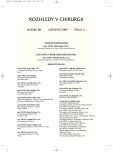Peritonitides Caused by Gastrointestinal Perforations – Analysis of an Elderly Patient Group
Authors:
I. Slaninka; J. Páral 1; M. Chobola; V. Motyčka; A. Ferko 1; V. Bláha 2
Authors‘ workplace:
Chirurgická klinika Lékařské fakulty UK v Hradci Králové a Fakultní nemocnice Hradec Králové
Přednosta kliniky: prof. MUDr. Alexander Ferko, CSc.
; Chirurgická klinika Lékařské fakulty UK v Hradci Králové a Fakultní nemocnice Hradec Králové
Přednosta kliniky: prof. MUDr. Alexander Ferko, CSc., Katedra válečné chirurgie, Fakulta vojenského
zdravotnictví, Univerzity obrany, Hradec Králové, vedoucí kate
1; Katedra válečné chirurgie, Fakulta vojenského zdravotnictví, Univerzity obrany, Hradec Králové
vedoucí katedry: doc. MUDr. Leo Klein, CSc.
2
Published in:
Rozhl. Chir., 2009, roč. 88, č. 11, s. 656-661.
Category:
Monothematic special - Original
Overview
Aim:
The aim of this study was to assess causes of peritonitides resulting from acute abdominal perforations in a group of elderly patients and to evaluate the yield of common classification systems in predicting the risks of postoperative complications, in particular of postoperative death rates.
Patients and Methods:
The retrospective analysis included 123 patients aged 70 y.o.a. and over (65 males, 58 females, the mean age was 78.7 y.o.a.), who underwent surgical revision for signs of peritonitis due to urgent GIT perforation, over a five-year period. The patients were assigned to groups based on their baseline diagnosis and on the procedure performed. The PSS (Peritonitis Severity Score) and MPI (Mannheim Peritonitis Index) classification systems factors were assessed. Statistical significance of the classification systems was evaluated, as well as their relation.
Results:
Overall death rate of the studied group was 30% (37 patients). The highest death rate related to the baseline diagnosis was observed in the GIT ischemia group (67%). Based on the procedure, the highest death rate was observed in the enterostomy group (75%). Overall morbidity related to a known wound infection was 24% (29 patients). Significant correlation between the both classification systems was demonstrated (Spearman’s correlation coefficient 0,86). Of the all studied factors creating classification schemes, the following proved statistically most significant: ASA IV, peritonitis Hinchey grade III–IV, existing immunosuppression and signs of organ failure (p < 0.0001).
Conclusion:
Perforation peritonitis remains a high risk condition, considering the postoperative morbidity rates, as well as the death rates. Perforation of the sigmoid diverticle was the commonest cause of GIT perforations in the elderly. The highest death rate was observed in those with ischemic ethiology. The PSS and MPI scoring systems are of high prediction value in the assessment of the risk of postoperative death.
Key words:
scoring system – acute abdomen – perforation peritonitis – elderly patients
Sources
1. Kriwanek, S., Armbruster, C., Beckerhinn, P. Prognostic factors for survival in colonic perforation. Int. J. Colorectal. Dis., 1994; 9: 158–162.
2. Bielecki, K., Kaminski, P., Klukowski, M. Large bowel perforation: morbidity and mortality. Tech. Coloproctol., 2002; 6: 177–182.
3. Komatsu, S., Shimomatsuya, T., Nakajima, M. Prognostic factors and scoring system for survival in colonic perforation. Hepatogastroenterology, 2005; 52: 761–764.
4. Biondo, S., Ramos, E., Fraccalviery, E. Comparative study of left colonic Peritonitis Severity Score and Mannheim Peritonitis Index. Br. J. Surg., 2006; 93: 616–622.
5. Billing, A., Frohlich, D. Prediction of outcome using the Mannhci peritonitis index in 2003 patients. Br. J. Surg., 1994; 81: 209–213.
6. Biondo, S., Ramos, E., Deiros, M. Prognostic factors for mortality in left colonic peritonitis: a new scoring system. J. Am. Coll. Surg., 2000; 191: 635–642.
7. Biondo, S., Pares, D., Marti Rague, J. Emergency operation for nondiverticular perforation of the left colon. Am. J. Surg., 2002; 183: 256–260.
8. Shinkawa, H., Yasuhara, H., Naka, S. Factors affecting the early mortality of patients with nontraumatic colorectal perforation. Surg. Today, 2003, 33: 13–17.
9. Makela, J. K., Kiviniemi, H., Laitinen, S. Prognostic factors of perforated sigmoid diverticulitis in the elderly. Digestive Surgery, 2005; 22: 100–106.
10. Constantinides, V. A., Tekkis, P. P., Athanasiou, T. Primary resection with anastomosis vs. Hartmanns procedure in nonelective surgery for acute colonic diverticulitis: a systematic review. Dis. Colon Rectum, 2006; 49: 966–981.
11. Chandra, V., Nelson, H., Larson, D. R. Impact of primary resection on the outcome of patients with perforated diverticulitis. Arch. Surg., 2004; 139: 1221–1224.
12. Veselý, V., Černý, V., Geiger, J. Resekce tlustého střeva podle Hartmanna-metoda stále živá. Rozhl. Chir., 2006; 85: 277–279.
13. Westaby, S., White, S. Wound infection. In: Westaby, S. Wound care. Toronto, 1986; 71–83.
14. Safioleas, M. C., Moulakakis, K. G. Acute mesenteric ischemia, a highly lethal disease with a devastating outcome. Vasa, 2006; 35: 106–111.
15. Wadman, M., Syk, I., Elmstahl, S. Survival after operations for ischemic bowel disease. Eur. J. Surg., 2000; 166: 872–877.
16. Acosta-Merida, M. A., Marchena-Gomez, J. Identification of risk for perioperative mortality in acute mesenteric ichemia. World J. Surg., 2006; 30: 1579–1585.
17. Kougias, P., Lau, D., El Sayed, H. F. Determinants of mortality and treatment outcome following surgical interventions for acute mesenteric ichemia. J. Vasc. Surg., 2007; 46: 467–474.
18. Kujath, P., Schwandner, O. Morbidity and mortality of perforated peptic gastroduodenal ulcer following emergency surgery. Langenbecks Arch. Surg., 2002; 7–8: 298–302.
19. Ucchedu, A., Floris, G. Surgery for perforated peptic ulcer in the elderly. Evaluation of factors influencing prognosis. Hepatogastroenterology, 2003; 50: 1956–1958.
Labels
Surgery Orthopaedics Trauma surgeryArticle was published in
Perspectives in Surgery

2009 Issue 11
Most read in this issue
- Case Report: Fat Embolism Syndrome – Grave Handicap after Traumatic Long-bones Fractures
- Traumatic Brain Injuries – Effects of Alcohol and Coffein on Intracranial Pressure and Cerebral Blood Flow
- Pacient s entrapment syndrómom a. poplitea a infekčnou endokarditídou (kazuistika)
- Cervical Disc Arthroplasty (Prodisc-C): Analysis of 3 to 4- Year Follow Up Results
